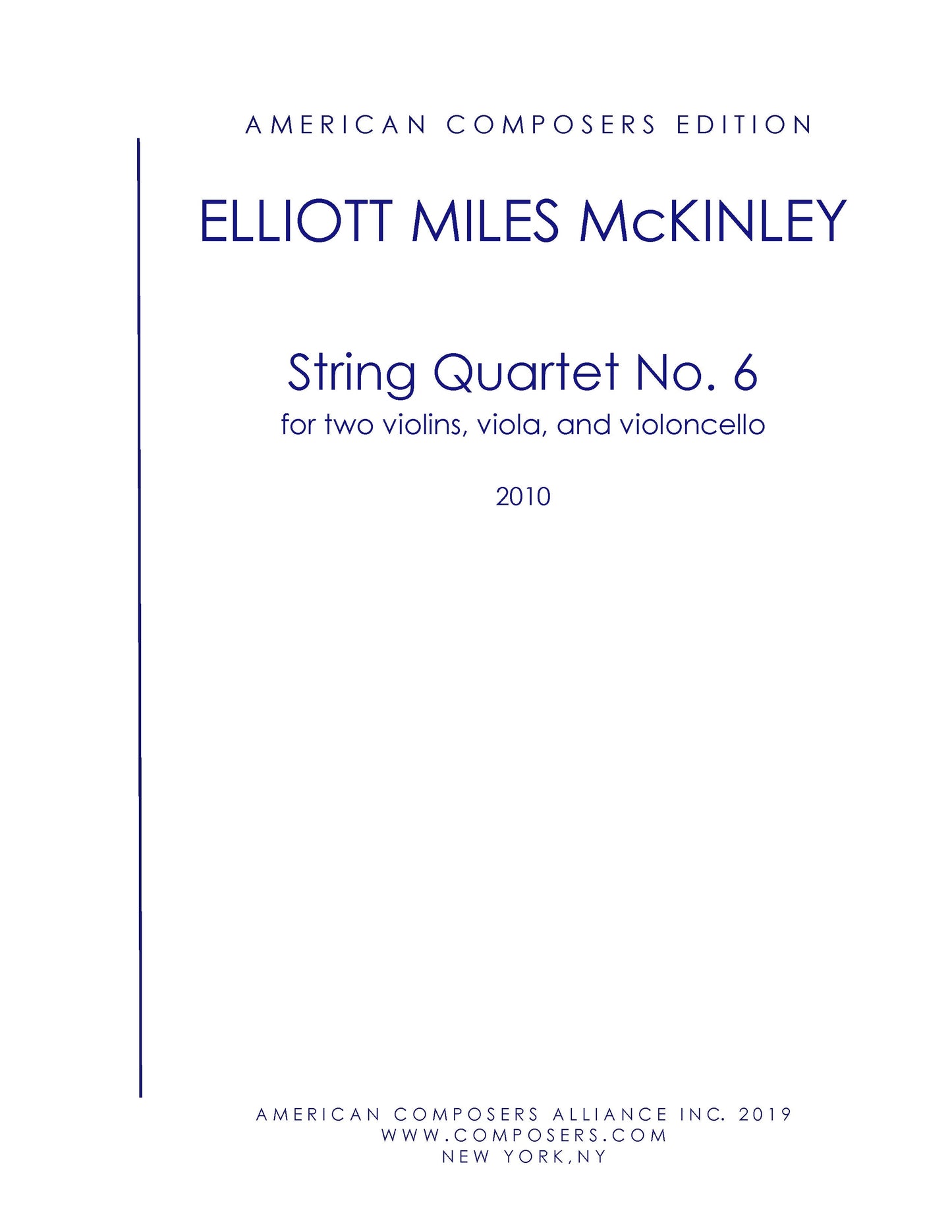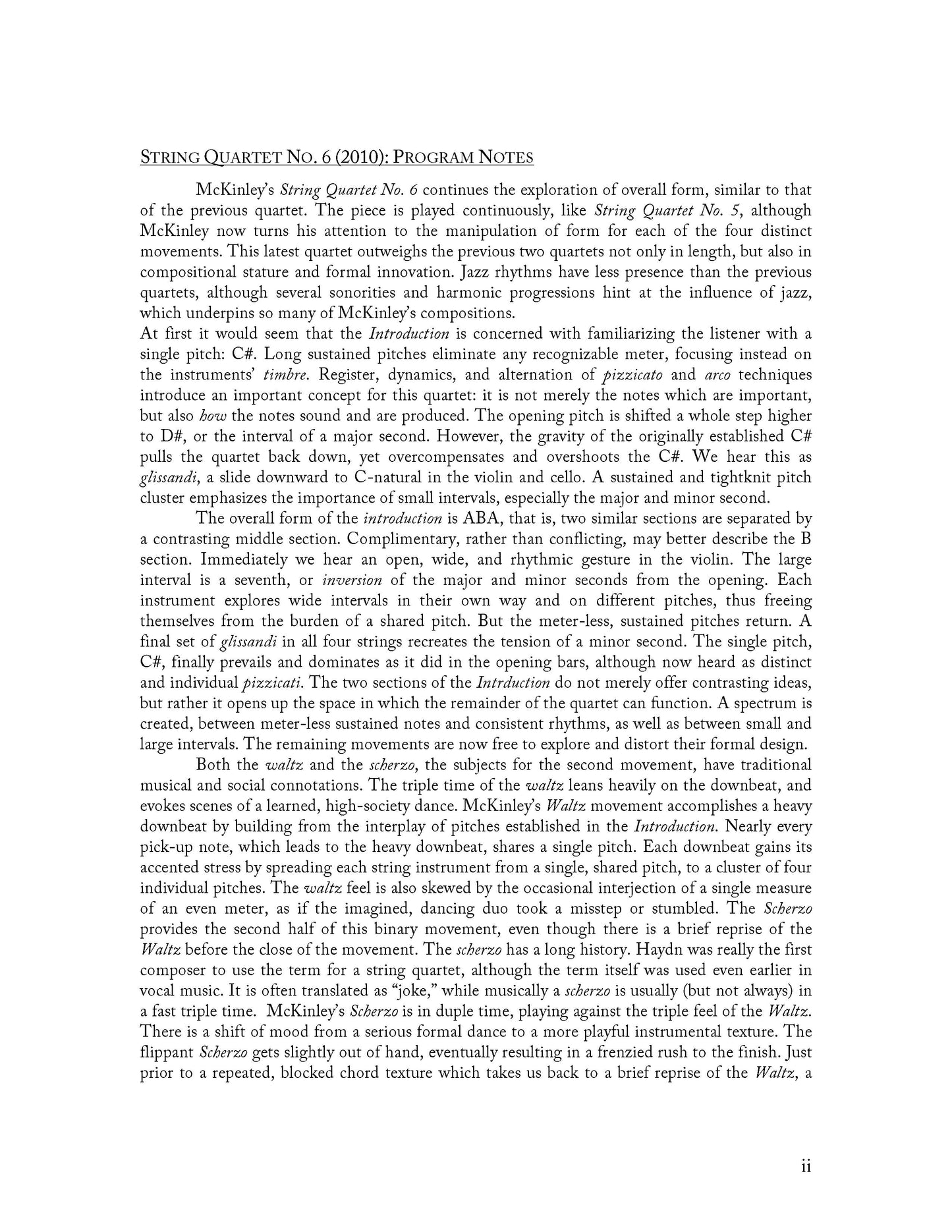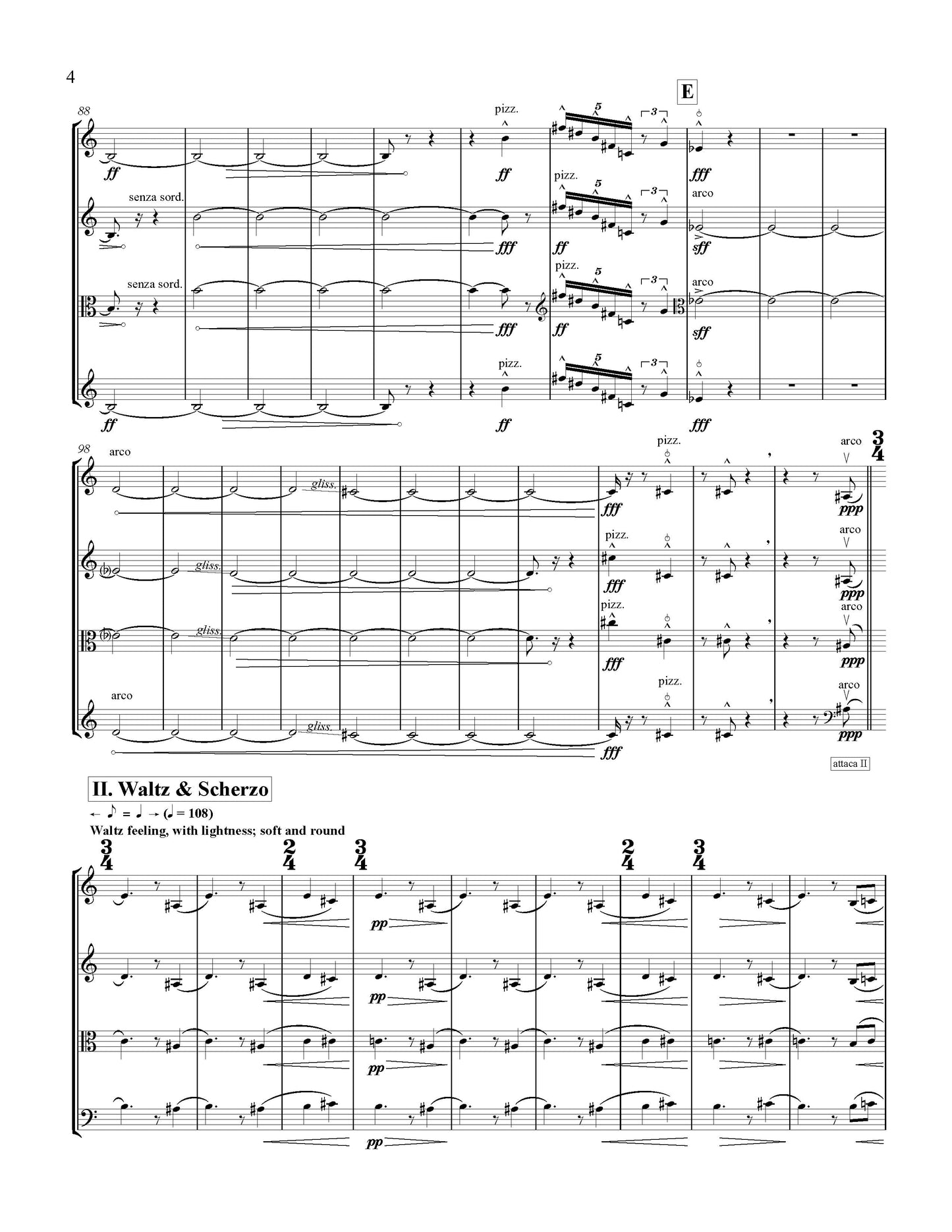String Quartet No. 6
String Quartet No. 6
string quartet
The most recent commission by the Martinů String Quartet to date, McKinley's String Quartet No. 6 continues the exploration of overall form, similar to that of the previous quartet. The piece is played continuously, like String Quartet No. 5, although McKinley now turns his attention to the manipulation of form for each of the four distinct movements. This latest quartet outweighs the previous two quartets not only in length, but also in compositional stature and formal innovation. Jazz rhythms have less presence than the previous quartets, although several sonorities and harmonic progressions hint at the influence of jazz, which underpins so many of McKinley's compositions.
At first it would seem that the Introduction is concerned with familiarizing the listener with a single pitch: C#. Long sustained pitches eliminate any recognizable meter, focusing instead on the instruments' timbre. Register, dynamics, and alternation of pizzicato and arco techniques introduce an important concept for this quartet: it is not merely the notes which are important, but also how the notes sound and are produced. The opening pitch is shifted a whole step higher to D#, or the interval of a major second. However, the gravity of the originally established C# pulls the quartet back down, yet overcompensates and overshoots the C#. We hear this as glissandi, a slide downward to C-natural in the violin and cello. A sustained and tightknit pitch cluster emphasizes the importance of small intervals, especially the major and minor second.
The overall form of the introduction is ABA, that is, two similar sections are separated by a contrasting middle section. Complimentary, rather than conflicting, may better describe the B section. Immediately we hear an open, wide, and rhythmic gesture in the violin. The large interval is a seventh, or inversion of the major and minor seconds from the opening. Each instrument explores wide intervals in their own way and on different pitches, thus freeing themselves from the burden of a shared pitch. But the meter-less, sustained pitches return. A final set of glissandi in all four strings recreates the tension of a minor second. The single pitch, C#, finally prevails and dominates as it did in the opening bars, although now heard as distinct and individual pizzicati. The two sections of the Introduction do not merely offer contrasting ideas, but rather it opens up the space in which the remainder of the quartet can function. A spectrum is created, between meter-less sustained notes and consistent rhythms, as well as between small and large intervals. The remaining movements are now free to explore and distort their formal design.
Both the waltz and the scherzo, the subjects for the second movement, have traditional musical and social connotations. The triple time of the waltz leans heavily on the downbeat, and evokes scenes of a learned, high-society dance. McKinley's Waltz movement accomplishes a heavy downbeat by building from the interplay of pitches established in the Introduction. Nearly every pick-up note, which leads to the heavy downbeat, shares a single pitch. Each downbeat gains its accented stress by spreading each string instrument from a single, shared pitch, to a cluster of four individual pitches. The waltz feel is also skewed by the occasional interjection of a single measure of an even meter, as if the imagined, dancing duo took a misstep or stumbled. The Scherzo provides the second half of this binary movement, even though there is a brief reprise of the Waltz before the close of the movement. The scherzo has a long history. Haydn was really the first composer to use the term for a string quartet, although the term itself was used even earlier in vocal music. It is often translated as "joke," while musically a scherzo is usually (but not always) in a fast triple time. McKinley's Scherzo is in duple time, playing against the triple feel of the Waltz. There is a shift of mood from a serious formal dance to a more playful instrumental texture. The flippant Scherzo gets slightly out of hand, eventually resulting in a frenzied rush to the finish. Just prior to a repeated, blocked chord texture which takes us back to a brief reprise of the Waltz, a rhythmic "joke" is created by pitting each instrument against the others in a 2:3:4:5 rhythmic ratio.
The most innovative movement of the quartet is the Chaccone. Traditionally, a chaconne involves melodic variations over a ground-bass, or repeated harmonic figuration in the lower instruments. McKinley's ground-bass is created in two of the four instruments. The second violin and viola, through the use of double-stops, create a chorale-like progression, heard initially without interruption from the remaining two instruments. These instruments, the first violin and cello, soon enter with alternating phrases. The cello enters first, with relatively slow motions between notes as well as rapid repetition of a single pitch. The contrasting violin phrases have rapid motion between notes, with several sustained pitches. As we heard in the Introduction, these two phrases appear "out of time," without a clearly defined metric pulse. By its third phrase, however, the cello begins a slow and regular pizzicato rhythm, soon mimicked by the violin at a faster pace. The cello soon falls into the background along with the ever-repeated background of the ground-bass, chorale-like progression, while the violin returns to its flamboyant outbursts. McKinley thus transforms the traditional formal nature of the chaconne, yet retains its integrity of variation over a ground-bass pattern.
The final movement, Interlude and Conclusion is another conflation of what might be considered two separate movements. A conclusion would certainly be expected, but McKinley also includes an interlude, which would typically come in the middle of the piece. The purpose of the Interlude does give us a musical break from the preceding music, but it also takes the listener back to more familiar musical elements from before, specifically some of the timbral sounds (the pizzicato/arco relationship, bowing sul ponticello, and especially the glissando). The Interlude leads directly into the Conclusion with delicate, running eighth-notes in all parts. Even though the texture of the Conclusion is different than most of the music in the previous movements, it does incorporate elements of each movement. Listen for melodic, harmonic, and even formal similarities in the faster, rhythmically-driven Conclusion. As a whole, String Quartet No. 6 shows that McKinley is far from running out of ideas. Compared to his earlier quartets, McKinley's latest installment displays innovation and creative playfulness with musical materials. It is the type of quartet that improves upon multiple hearings.
--PETER SMUCKER, UNIVERSITY OF CHICAGO. FEBRUARY 2011.
Movements: I. Introduction, II. Waltz and Scherzo, III. Chaccone, IV. Interlude and Conclusion
Authored (or revised): 2010
Duration (minutes): 26.0
First performance: February 14, 2010. The Martinů Quartet. Prague, Czech Republic.
Book format: score with set of 4 parts
SKU
ACA-MCKE-004Subtotal
$55.00Couldn't load pickup availability






PDF Download Policy
Shipping and Returns
Purchasing digital PDFs from American Composers Edition grants you an exclusive license for your own use of the files, including performance, as well as permission to duplicate the score and files as required for that purpose. Any other use, including commercial recording, may require an additional license. PDF files are not refundable and are permanently licensed to the buyer.
Shipping
You may choose your shipping method on checkout.
In the USA we usually use USPS Priority Mail or Media Mail or UPS Ground services. We ship worldwide using US International Postal Mail Priority, First Class International Mail, or UPS Global.
Return Policy
Orders received damaged will be replaced at no additional charge. Refunds requested will be issued back to the original payment method.






